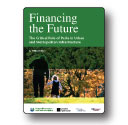 NRPA and the Urban Institute released a new report, “Financing the Future: The Critical Role of Parks in Urban and Metropolitan Infrastructure.” The report, written by noted author, urban planner, and former mayor of Ventura, California, William Fulton, analyzes discussion from a roundtable held in Washington, DC in the fall of 2011 with national experts including park directors, mayors, and urban planners.
NRPA and the Urban Institute released a new report, “Financing the Future: The Critical Role of Parks in Urban and Metropolitan Infrastructure.” The report, written by noted author, urban planner, and former mayor of Ventura, California, William Fulton, analyzes discussion from a roundtable held in Washington, DC in the fall of 2011 with national experts including park directors, mayors, and urban planners.
The roundtable was with invited experts, but many NRPA members tuned in to the live-streamed webcast of the discussion. The purpose of this event was to explore the role and impact of parks in America’s cities, counties and urban metropolitan areas as these traditional public services face ever greater financial constraints and the rapidly changing social landscape of contemporary America.
With eight in 10 Americans now making their home in metropolitan areas, urban parks have become a critical part of urban infrastructure. However, the viability and sustainability of urban public parks and recreation resources are increasingly in question for those who need them the most.
The summary report succinctly outlines the discussion of the diverse group of experts from many disciplines including urban planning, tax policy, real estate health, education, and conservation who attended the roundtable. The summary of their discussion regarding the needs of urban cities and counties points to future research and action steps to address critical funding issues facing urban parks.
Eight questions are raised in the report under four major topical areas: Equity, Fiscal Viability, Impacts and Outcomes, and Partnerships:
- What parks and recreation services should be offered for free?
- How can equitable access to parks and recreation programs be maintained in times of fiscal constraint?
- How can parks and recreation departments ensure short payback periods for “greening” of facilities?
- How can outside funds be raised to support capital retrofits as well as ongoing maintenance and management?
- What metrics should be used to measure success; how can park and recreation professionals shift to metrics focused on outcomes?
- Can the value of parks and recreation as a “front-end investment” in public health and safety be quantified?
- What is the appropriate role of corporate donations and/or corporate involvement?
- Should parks and recreation departments play a role in building the stability of nonprofit organizations that are entrusted with programs?
NRPA is very interested to hear your opinions regarding these questions, and any other comments you might have on the report. Do you agree these are the most important questions regarding issues related to long-term viability of funding for urban parks? Do you have other suggestions for possible solutions for urban park funding or perhaps a successful approach you’ve implemented? Please share your thoughts on the report and your thoughts on the most important issues facing urban parks today by leaving your comment below.

